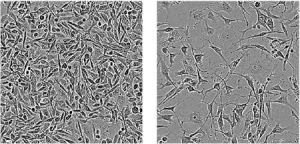Solving a long-standing mystery about the desert's rock art canvas
2021-07-02
(Press-News.org) Wander around a desert most anywhere in the world, and eventually you'll notice dark-stained rocks, especially where the sun shines most brightly and water trickles down or dew gathers. In some spots, if you're lucky, you might stumble upon ancient art - petroglyphs - carved into the stain. For years, however, researchers have understood more about the petroglyphs than the mysterious dark stain, called rock varnish, in which they were drawn.
In particular, science has yet to come to a conclusion about where rock varnish, which is unusually rich in manganese, comes from.
Now, scientists at the California Institute of Technology, the Department of Energy's SLAC National Accelerator Laboratory and elsewhere think they have an answer. According to a recent paper in Proceedings of the National Academy of Sciences, rock varnish is left behind by microbial communities that use manganese to defend against the punishing desert sun.
The mystery of rock varnish is old, said Usha Lingappa, a graduate student at Caltech and the study's lead author. "Charles Darwin wrote about it, Alexander von Humboldt wrote about it," she said, and there is a long-standing debate about whether it has a biological or inorganic origin.
But, Lingappa said, she and her colleagues didn't actually set out to understand where rock varnish comes from. Instead, they were interested in how microbial ecosystems in the desert interact with rock varnish. To do so, they deployed as many techniques as they could come up with: DNA sequencing, mineralogical analyses, electron microscopy, and - aided by Stanford Synchroton Radiation Lightsource (SSRL) scientist Samuel Webb - advanced X-ray spectroscopy methods that could map different kinds of manganese and other elements within samples of rock varnish.
"By combining these different perspectives, maybe we could draw a picture of this ecosystem and understand it in new ways," Lingappa said. "That's where we started, and then we just stumbled into this hypothesis" for rock varnish formation.
Among the team's key observations was that, while manganese in desert dust is usually in particle form, it was deposited in more continuous layers in varnish, a fact revealed by X-ray spectroscopy methods at SSRL that can tell not only what chemical compounds make up a sample but also how they are distributed, on a microscopic scale, throughout the sample.
That same analysis showed that the kinds of manganese compounds in varnish were the result of ongoing chemical cycles, rather than being left out in the sun for millennia. That information, combined with the prevalence of bacteria called Chroococcidiopsis that use manganese to combat the oxidative effects of the harsh desert sun, led Lingappa and her team to conclude that rock varnish was left behind by those bacteria.
For his part, Webb said that he always enjoys a manganese project - "I've been a mangaphile for a while now" - and that this project arrived at the perfect time, given advances in X-ray spectroscopy at SSRL. Improvements in X-ray beam size allowed the researchers to get a finer-grained picture of rock varnish, he said, and other improvements ensured that they could get a good look at their samples without the risk of damaging them. "We're always tinkering and fine-tuning things, and I think it was the right time for a project that maybe 5 or 10 years ago wouldn't really have been feasible."
INFORMATION:
The research was supported by the National Science Foundation, the National Institutes of Health and the National Aeronautics and Space Administration. SSRL is a DOE Office of Science user facility.
Citation: Usha F. Lingappa et al., Proceedings of the National Academy of Sciences, 22 June 2021 (10.1073/pnas.2025188118)
ELSE PRESS RELEASES FROM THIS DATE:
2021-07-02
Neuroscientists at the University of Massachusetts Amherst have demonstrated in new research that dopamine plays a key role in how songbirds learn complex new sounds.
Published in the Journal of Neuroscience, the finding that dopamine drives plasticity in the auditory pallium of zebra finches lays new groundwork for advancing the understanding of the functions of this neurotransmitter in an area of the brain that encodes complex stimuli.
"People associate dopamine with reward and pleasure," says lead author Matheus Macedo-Lima, who performed the research in the lab of senior author Luke Remage-Healey as a Ph.D. student in UMass Amherst's Neuroscience and Behavior graduate program. "It's a very well-known concept that dopamine is involved in learning. ...
2021-07-02
In cancer research, it's a common goal to find something about cancer cells -- some sort of molecule -- that drives their ability to survive, and determine if that molecule could be inhibited with a drug, halting tumor growth. Even better: The molecule isn't present in healthy cells, so they remain untouched by the new therapy.
Plenty of progress has been made in this approach, known as molecular targeted cancer therapy. Some current cancer therapeutics inhibit enzymes that become overactive, allowing cells to proliferate, spread and survive beyond ...
2021-07-02
What The Study Did: Researchers in this study aimed to determine how each state and the District of Columbia planned to ensure equitable COVID-19 vaccine distribution.
Authors: Juan C. Rojas, M.D., of the University of Chicago, is the corresponding author.
To access the embargoed study: Visit our For The Media website at this link https://media.jamanetwork.com/
(doi:10.1001/jamanetworkopen.2021.15653)
Editor's Note: The article includes conflict of interest and funding/support disclosures. Please see the article for additional information, including other authors, author contributions and affiliations, conflict of interest and financial ...
2021-07-02
What The Study Did: Changes in the use of women's preventive health services during the COVID-19 pandemic, including screening for sexually transmitted infections, breast and cervical cancer, and obtaining contraceptives from pharmacies are described by researchers in this study.
Authors: Nora V. Becker, M.D., Ph.D., of the University of Michigan Medical School in Ann Arbor, is the corresponding author.
To access the embargoed study: Visit our For The Media website at this link https://media.jamanetwork.com/
(doi:10.1001/jamahealthforum.2021.1408)
Editor's Note: The article includes conflict of interest disclosures. Please see the article for additional information, including other authors, ...
2021-07-02
What The Study Did: Researchers estimated the frequency and magnitude of surprise bills for deliveries and newborn hospitalizations, which are the leading reasons for hospitalization in the United States, to illustrate the potential benefits of federal legislation that will protect families from most surprise bills. Potential surprise bills were defined as claims from out-of-network clinicians and ancillary service providers, such as an ambulance.
Authors: Kao-Ping Chua, M.D., Ph.D., of the University of Michigan Medical School in Ann Arbor, is the corresponding author.
To access the embargoed study: Visit our For The Media website at this link https://media.jamanetwork.com/
(doi:10.1001/jamahealthforum.2021.1460)
Editor's Note: The article includes conflict of ...
2021-07-02
What The Study Did: This study investigates whether different risk factors identify the same hospitals caring for a high proportion of disadvantaged patients using seven definitions of social risk.
Authors: Susannah M. Bernheim, M.D., M.H.S., of the Yale University School of Medicine in New Haven, Connecticut, is the corresponding author.
To access the embargoed study: Visit our For The Media website at this link https://media.jamanetwork.com/
(doi:10.1001/jamahealthforum.2021.1323)
Editor's Note: The article includes conflict of interest and funding/support ...
2021-07-02
PHILADELPHIA-- While more women are entering the field of academic medicine than ever before, they are less likely to be recognized as experts and leaders; they are less likely to receive prestigious awards, be promoted to full professorships, hold leadership roles, or author original research or commentaries in major journals. What's more, articles published by women in high-impact medical journals also have fewer citations than those written by men, especially when women are primary and senior authors, according to new research from the Perelman School of Medicine and the Leonard Davis Institute of Health Economics at the University of Pennsylvania, published today in JAMA Open Network.
Researchers found that of the 5,554 articles published in 5 leading academic medical journals ...
2021-07-02
The Mutriku wave power plant was built on the Mutriku breakwater, a site with great wave energy potential, and has been in operation since 2011. With 14 oscillating water columns to transform wave energy, it is the only wave farm in the world that supplies electricity to the grid on a continuous basis. In general, technologies that harness the power of the waves to produce electricity are in their infancy, and this is precisely what is being explored by the UPV/EHU's Research Group EOLO, which focusses on Meteorology, Climate and Environment, among many ...
2021-07-02
CHAPEL HILL, NC - Migraine is one of the largest causes of disability in the world. Existing treatments are often not enough to offer full relief for patients. A new study published in The BMJ demonstrates an additional option patients can use in their effort to experience fewer migraines and headaches - a change in diet.
"Our ancestors ate very different amounts and types of fats compared to our modern diets," said co-first author Daisy Zamora, PhD, assistant professor in the UNC Department of Psychiatry in the UNC School of Medicine. "Polyunsaturated fatty acids, which our bodies do not produce, have increased substantially in our diet due to the addition of oils such as corn, soybean and cottonseed to many processed foods like chips, crackers and granola."
The classes of polyunsaturated ...
2021-07-02
According to studies in recent years, air pollution affects the thyroid. Thyroid hormones are essential for regulating foetal growth and metabolism, and play an important role in neurological development. Thyroxine (T4) is the main thyroid hormone that is circulating and the thyroid-stimulating hormone is TSH. At 48 hours newborn babies undergo a heel prick test in which thyroxine and TSH levels in the blood are measured. In fact, if the balance of these thyroid hormones is not right, the risk of developing serious diseases increases. That is why, "this study set out to analyse the relationship between atmospheric pollution during pregnancy and the level ...
LAST 30 PRESS RELEASES:
[Press-News.org] Solving a long-standing mystery about the desert's rock art canvas




